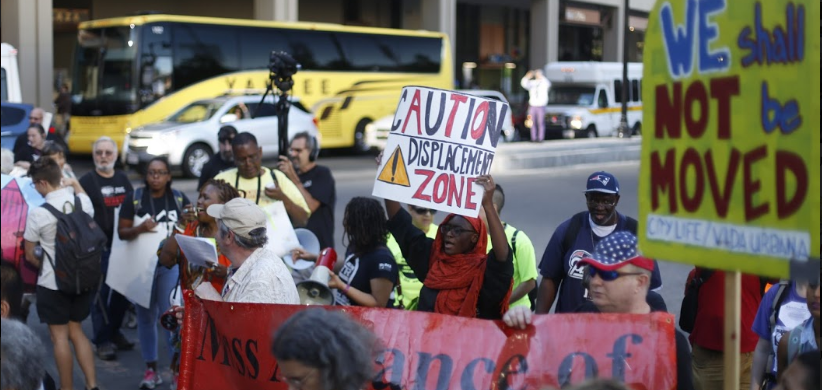By Ryan Grewal and Alex Eng, news staff
Hundreds of residents from across Boston protested against what they called unfair municipal housing policies in downtown Boston on Thursday, Sept. 22. Many expressed frustration toward college development in their neighborhoods, especially concerning an agreement Northeastern had allegedly broken with the Roxbury Crossing community.
City Councilor Tito Jackson (D-7) joined demonstrators outside City Hall. Jackson, whose district includes much of Roxbury as well as the southern part of Northeastern’s campus, accused Northeastern of reneging on an agreement with the Roxbury community regarding the building of a new dormitory on the corner of Burke Street and Columbus Avenue.
“Northeastern spent a year and a half with us doing an Institutional Master Plan, and they turned around and betrayed the community after that,” Jackson said in an interview during the protest. “The [Burke Street project] that was supposed to be eight stories is now 22 stories, 812 beds.”
Jackson said that Northeastern pushes for gentrification and the displacement of Roxbury residents.
“I have an issue with President Aoun and the administration at Northeastern [for] showing a complete and utter disregard and disrespect for the agreement they spent a year and a half crafting with the community,” Jackson said.
Matt McDonald, a university spokesperson, defended the actions of the university in amending the initial plans for the Burke Street property in a Sept. 26 email to The News.
“The university has been open and transparent throughout this process, and any claims otherwise are disingenuous,” he said. “The university hosted four community meetings about the Burke Street residence hall project, providing an open forum for robust community input.”
In its 2013 Institutional Master Plan (IMP), Northeastern outlined its future development plans to the Boston Redevelopment Authority (BRA), now the Boston Planning & Development Agency, including its intention to build the dormitory on Burke Street and Columbus Avenue.
Creating an IMP involves engaging with communities affected by development, and as such the Burke Street redevelopment plan included agreements reached between the university, Roxbury residents and elected officials like Jackson.
The process of changing an IMP does not involve the community; instead, it simply requires a notification form to be submitted to the BRA.
Northeastern submitted a notification form amending its plans for the Burke Street property to the BRA in January. The square footage of the building was increased by 55 percent – creating approximately 800 beds rather than the 350-600 initially proposed, according to the amendment.
Holding a National Renters’ Day of Action protest, the Right 2 Remain Coalition – a group of activists from Right to the City, Union United, City Life and other neighborhood civic groups – met at the steps of the Greater Boston Real Estate Board (GBREB) to unveil a six-by-eight foot poster and issue the municipal housing authorities a “human rights violation” for “blocking tenant protection and stabilizing community ordinances.”
Kalila Barnett, the executive director of Alternatives for Community & Environment, discussed Right 2 Remain’s goal to grant greater community control over community land.
“People who are working and contributing to the economy of the community are being forced to leave, and we are here, out on the streets, to say that is not okay,” she said.
Barnett spoke of how a family looking for an apartment would have to compete with a pool of three to four college students who could rent out a room together and be in a better position to afford it.
“A lot of students live in Boston, and many landlords are taking advantage of that,” she said, noting that landlords have raised the price of housing to $3,000-$4,000 a month. “A family can’t afford that.”
Many protesters expressed anger and frustration toward academic institutions like Northeastern for expanding into their neighborhoods. Several protesters echoed Jackson’s claims that universities were contributing to the demise of community control over Boston development.
Robert Folan Johnson, a Huntington Avenue resident, argued that university linkage or voluntary payments often do not compensate for the net loss to residents in terms of unemployment, rising rents and unjust evictions as a result of university development.
Johnson, a member of the Boston Homeless Solidarity Committee, expressed the grave concerns his group has concerning the Burke Street housing project agreement.
“It will be the loss of yet another Boston neighborhood to become a de facto campus,” he said.
Following the construction of the International Village dormitory in 2009, Northeastern has further developed in the Roxbury section of Columbus Avenue with the Davenport Commons dormitory and the under-construction Interdisciplinary Science and Engineering academic building.
Northeastern also plans to build a new athletic complex on the site of the William E. Carter playground near Columbus Avenue and enhance the infrastructure of the Ruggles MBTA station, a change the comunity has desired, with a $20 million federal grant, as The News previously reported.
Leaders from Right 2 Remain closed the Day of Action with a tri-lingual speech, in Cantonese, Spanish and English, on the tennis court of Reggie Wong Memorial Park in Chinatown.
John Labella, a Fenway resident, characterized the event as a fledgling movement that had the emotional energy to continue, but would require more focus to make an impact.
“It’s a good first step. The next step is to find some good tools to really hit home,” Labella, who spoke at the protest, said. “All they can do is scream. They don’t have their words yet.”
Photo by Amanda Barr















